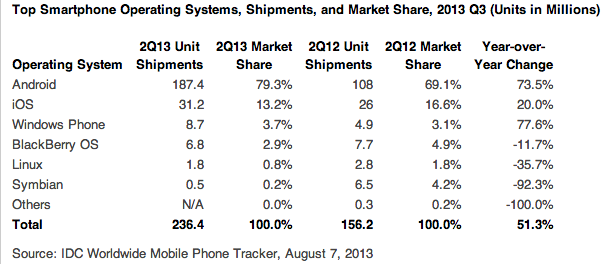Android smartphone shipments grew a whopping 73.5 percent between the second quarter of 2012 and Q2 2013, according to research firm IDC’s latest numbers. 187.4 million Android-powered phones shipped in the most recent quarter, representing 79.3 percent of all smartphones shipped during the quarter. The next closest smartphone platform was iOS, which shipped just 31.2 million units, accounting for 13.2 percent of overall share.
Apple’s mobile OS still blew away its next closest competitor (and still grew 20 percent in terms of device shipments year over year), Windows Phone, which saw 8.7 million handsets shipped for 3.7 percent share of the global market. But Windows Phone also experienced growth at roughly the same rate, with shipments overall climbing 77.6 percent year over year. BlackBerry, predictably, hurt the worst of the major players, dropping from 4.9 percent overall share to just 2.9 percent, and shipping 11.7 percent fewer devices than during the same time last year.
What’s causing the big Android bump IDC says the Samsung Galaxy S4 was a strong driver, but LG, Huawei, Lenovo and ZTE also had really good quarters with shipments in the double digits. The Android platform represented a win for almost everyone playing in that sandbox, however, as even small manufacturers saw success targeting small, niche markets in developing countries with affordable smartphones.
 Windows Phone owes almost all of its growth to Nokia, which accounted for 81.6 percent of all smartphones shipped based on Microsoft’s mobile platform during the quarter. BlackBerry hit a new all-time low, in terms of IDC’s history of tracking market share. IDC says not to count them out because of BB10 progress, but it’s no secret that things are looking grim for the Canadian smartphone pioneer.
Windows Phone owes almost all of its growth to Nokia, which accounted for 81.6 percent of all smartphones shipped based on Microsoft’s mobile platform during the quarter. BlackBerry hit a new all-time low, in terms of IDC’s history of tracking market share. IDC says not to count them out because of BB10 progress, but it’s no secret that things are looking grim for the Canadian smartphone pioneer.
The big takeaway here is pretty clear, in terms of the top two players: Android is on fire because of choice, availability and price point in emerging markets focused on shifting to smartphones from feature phones on limited budgets. That means it’s even more crucial to watch what Apple debuts this fall in terms of a low-cost iPhone device, which is rumored to be based around the iPhone 5 and sport a plastic back that’s cheaper to produce.
